To prepare for a Live Scan, you’ll need to obtain the required forms from the requesting agency and verify their completeness. Schedule an appointment with a certified provider and gather a valid photo ID along with applicable fees. Familiarize yourself with the electronic scanning process and confirm you have an ORI number if needed. Understanding agency requirements, such as FBI regulations, is essential. By following these steps, you’ll guarantee a smooth process. Continuing with these guidelines will help you navigate the entire procedure efficiently.
Preparation for Live Scan
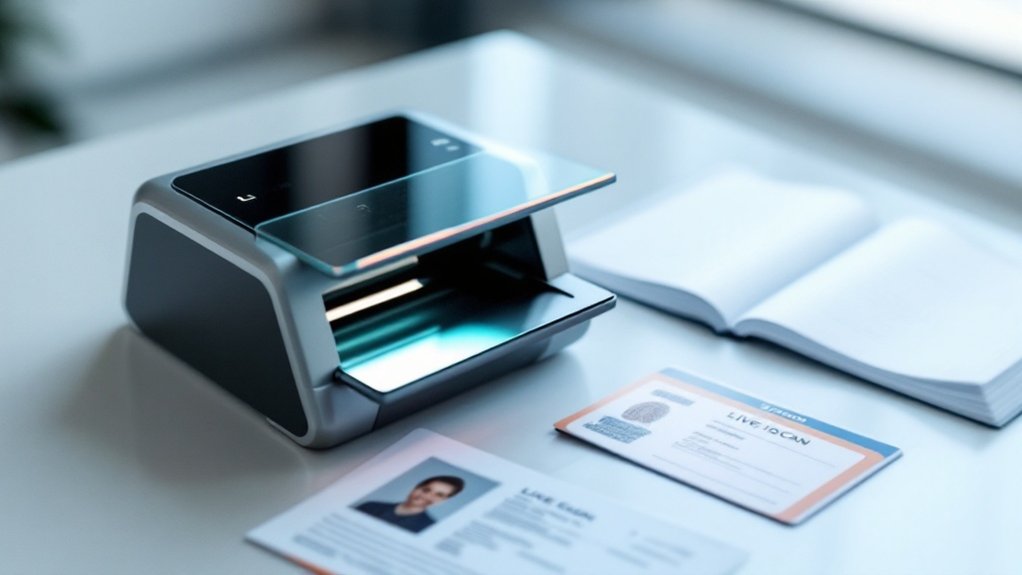
To prepare for Live Scan fingerprinting, you’ll need to take several steps. First, obtain the required forms from the requesting agency and fill out your personal details. Guarantee the form includes the Request for Live Scan service section and verify its completeness. Next, schedule an appointment with a certified provider, confirming their availability and location.
Gather necessary items like a valid photo ID and applicable fees. Check the accepted payment methods and any additional identification requirements. Familiarize yourself with the electronic scanning process, which is non-invasive and ink-free. Understand that quality fingerprint images are indispensable, and be prepared for potential rescan if needed. Additionally, recognizing the necessity for background checks is crucial as it ensures compliance with employment, licensing, or certification requirements.
Understanding Agency Requirements
When you’re preparing for live scan fingerprinting, understanding the requirements of various agencies is essential. For the FBI, live scan devices must be approved for interoperability with the Next Generation Identification system, and an Originating Agency Identification (ORI) number is required. Fingerprint operators need certification, and adherence to FBI regulations is pivotal. Becoming an authorized fingerprinting agency involves obtaining necessary approvals and equipment, such as a live scan device, to legally operate and provide services compliant with regulatory standards. At the state and local levels, registration with state agencies is necessary, and regulations vary by state. Some states, like California, require state certification for fingerprint rollers. Industry-specific agencies, such as FINRA and NFA, have unique requirements. You must handle personal data securely and guarantee equipment compliance with agency standards.
Fees and Costs Associated With Live Scan
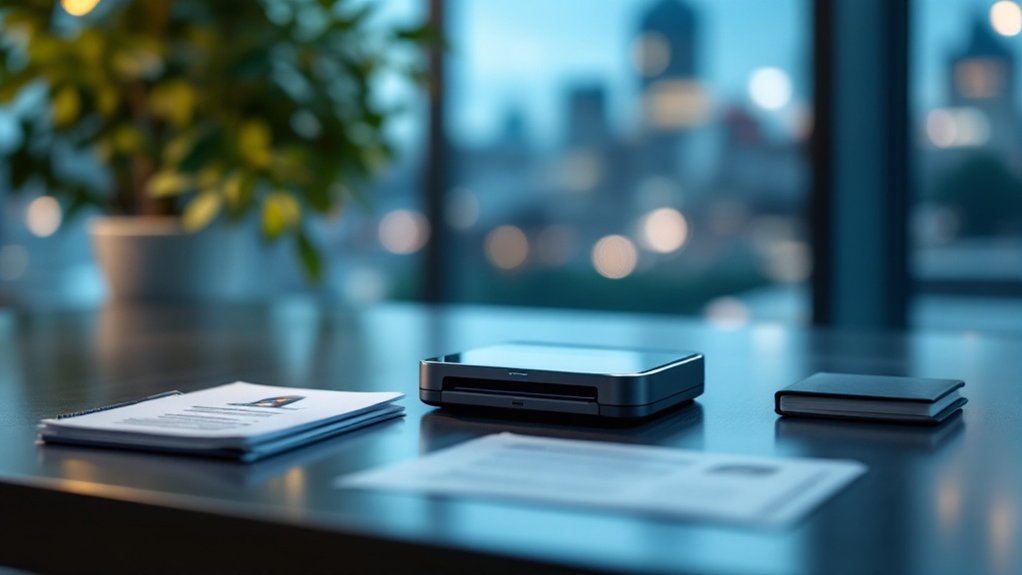
When you undergo Live Scan fingerprinting, you’ll encounter various fees, including a rolling fee that typically ranges from $20 to $40, depending on the service provider. The standard FBI fee is $17, while the DOJ fee generally costs $32, though it can vary based on the application type. Your total cost will depend on whether you need both DOJ and FBI checks, as well as any additional services or discounts available, such as waived fees with a billing number. It is advisable to contact the requesting agency to confirm the exact fees, as they may change without notice, especially regarding the DOJ fees.
Fees Overview
The cost of Live Scan fingerprinting varies based on several factors, including the type of background check required and the service provider. General fees include a DOJ fee of about $32 and an FBI fee of approximately $17. Live Scan service fees typically range from $20 to $50, covering the fingerprint rolling process.
You’ll find variations in provider fees, with rolling fees ranging from $20 to $40. Some services offer discounts for bulk fingerprinting or lower fees for specific services. Billing numbers can cover government fees if provided by the requesting agency. Payment methods vary by provider, so it’s best to confirm them beforehand.
Live Scan fingerprinting is often required for jobs involving contact with vulnerable individuals, such as children, and is a mandatory step for ensuring comprehensive background checks in sensitive sectors.
Service Costs
Live Scan fingerprinting involves a range of costs that can vary considerably based on several factors, including the type of background check required and the service provider you choose. Rolling fees typically range from $20 to $50, while government fees include a $32 DOJ charge and a $17 FBI fee if applicable. Some agencies may cover these fees with a billing number, reducing your costs. To manage costs effectively, confirm fees with your provider beforehand and check if your agency has a billing number. Choosing a provider with competitive rolling fees can also help. Understanding the specific background checks required will guarantee accurate cost estimation. Additionally, the total cost can range from $50 to $100, depending on whether both state and federal checks are required, involving a total cost that varies based on these factors.
Scheduling a Live Scan Appointment
Scheduling a live scan appointment is a straightforward process that you can manage online, over the phone, or in person, depending on the provider’s options. Booking early guarantees availability and reduces wait times. It’s important to choose a certified provider for quality service and confirm appointment details to avoid confusion.
Some key benefits of scheduling include:
- Reduced wait times compared to walk-ins
- Guaranteed availability of equipment and personnel
- A more streamlined and efficient process
- Cost-effectiveness by avoiding unnecessary delays
Additionally, having your ORI number ready before scheduling is crucial, as some providers may not proceed without it, ensuring that your fingerprint results are directed to the correct agency.
Required Identification and Documentation
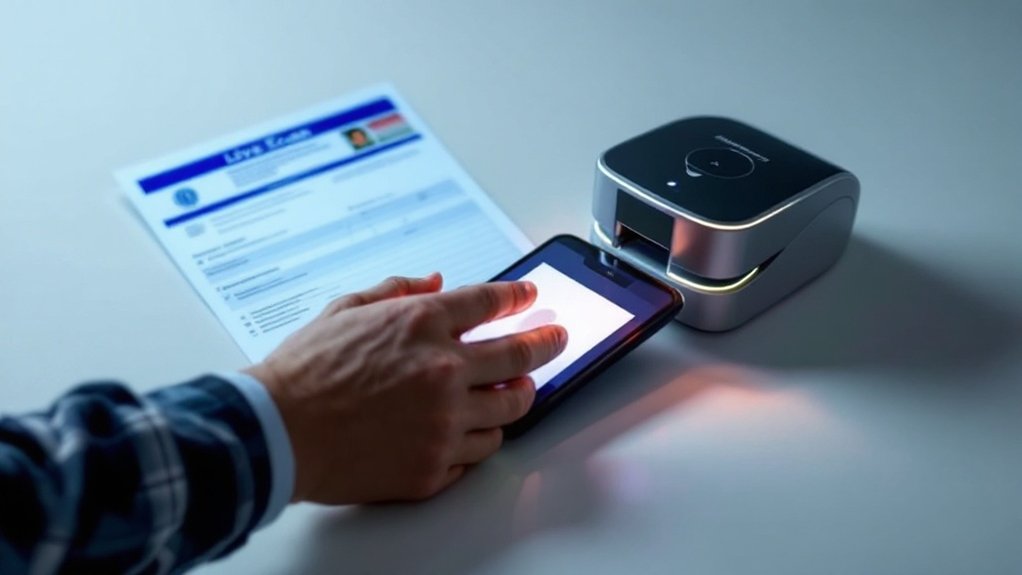
When you’re ready to undergo a Live Scan fingerprinting process, you’ll need to gather specific identification and documentation. A valid government-issued photo ID like a driver’s license or state ID card is necessary. You can also use a passport, military ID, or a Green Card as identification. Additionally, you’ll need a Request for Live Scan Service form, which includes the ORI number for result submission, and a payment method. It’s crucial to have a payment method ready to cover the costs associated with fingerprint capture and background check processing. You may also need to provide a Social Security Number or ITIN, and some agencies require a reference or application number. Secondary identification options include a state-issued birth certificate or a U.S. Tribal ID. Guarantee you have all required documents to avoid delays.
Live Scan Equipment and Software Essentials
Once you’ve gathered the necessary identification and documentation, the next step involves selecting and setting up the right equipment and software for the Live Scan fingerprinting process. You’ll need a ten-print fingerprint scanner, a computer that meets the vendor’s requirements, and an FBI-certified printer for printing on various card types. An adjustable table helps accommodate clients of different heights.
To ensure a smooth process, it is crucial that providers maintain accurate records, including keeping copies of all documents associated with fingerprinting until the applicant’s personnel security screening request is completed, which involves handling sensitive identification documents securely.
Fingerprint quality evaluation, compatibility, data management, and customization are key considerations:
- Fingerprint Quality Evaluation: Software should assess fingerprint quality.
- Compatibility: Guarantee software works with your scanner model.
- Data Management: Efficiently capture, store, and retrieve biometric data.
- Customization: Tailor configurations to fit specific business needs.
The Live Scan Fingerprinting Process
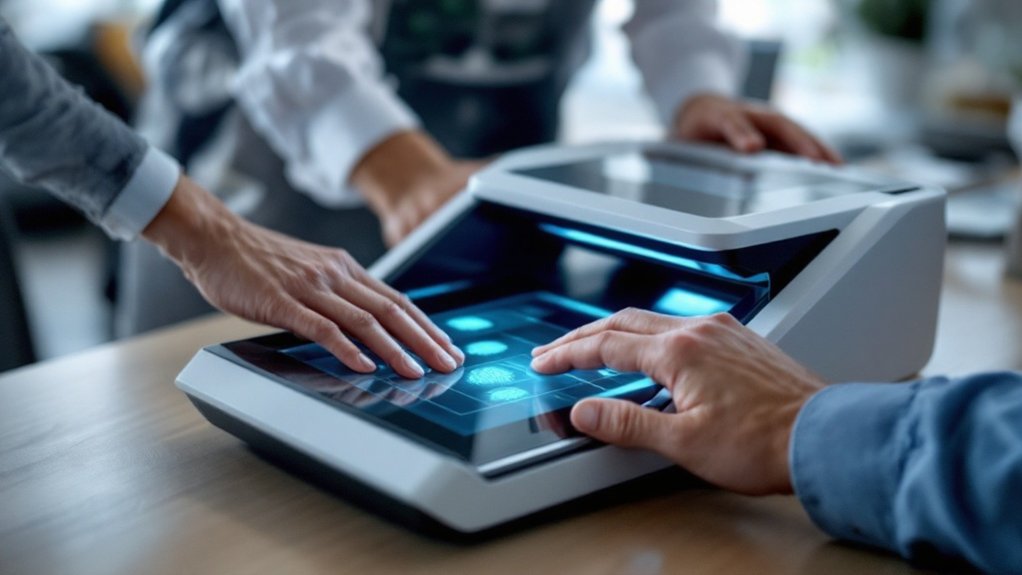
When you undergo Live Scan fingerprinting, you’ll start by having your fingerprints electronically captured using a specialized scanner. This process involves capturing both rolled and flat scans, including thumbs and four-finger slaps from each hand, ensuring that the images are of high quality through real-time checks. Once your fingerprints are captured, they are transmitted electronically to the appropriate agency for processing, which can include law enforcement or licensing bodies, depending on the purpose of the background check. This method is particularly efficient because it uses digital technology to eliminate the need for ink and paper, making it a more accurate and rapid process compared to traditional methods.
Fingerprint Capture
The Live Scan fingerprinting process begins with preparation, where you’ll need to obtain the appropriate Live Scan form and a valid photo ID, such as a driver’s license or passport. This guarantees that your identity is verified and your fingerprints are accurately linked to your personal details.
Some key aspects of the fingerprint capture process include:
- Digital Scanning: Fingerprints are captured electronically, eliminating the need for ink.
- Quality Checks: Real-time image quality checks confirm satisfactory prints.
- Certified Operators: The process is conducted by certified operators to ascertain accuracy.
- Efficiency: The electronic process reduces errors and accelerates the overall fingerprinting process.
The entire process is streamlined by using an ORI number to direct where the background check results should be sent, ensuring that the information is delivered to the correct agency efficiently.
Data Transmission
After your fingerprints have been captured and verified for quality, the next step involves preparing and transmitting the data. Your personal details and contact information are inputted into the system alongside your fingerprint data. This information is verified by the Live Scan operator to guarantee accuracy and completeness.
The data is then transmitted electronically to state or federal agencies, such as the Department of Justice (DOJ) or the FBI, using specialized software that safeguards secure and efficient transfer. This process drastically reduces processing time compared to traditional methods and sends data to Automated Fingerprint Identification Systems (AFIS) or Automated Biometric Identification Systems (ABIS). Real-time quality checks guarantee high-quality data transmission.
Post-Scanning Procedures and Form Completion
Once you’ve completed the live scan fingerprinting process, several key steps guarantee that your data is accurately processed and securely handled. You will receive a copy of the completed form as proof of the process. The agency then processes the fingerprint data for background checks or other purposes.
Some important aspects of post-scanning procedures include:
- Form Completion: Ensuring all sections are filled out correctly.
- Data Verification: The operator checks the quality of the captured data.
- Electronic Transmission: Securely sending the data to the designated agency.
- Record Keeping: Copies of the form serve as proof of payment and completion. Additionally, the entire process is typically facilitated by certified providers, such as those offering mobile services, which can be particularly convenient for individuals with busy schedules.
Ensuring Legal and Regulatory Compliance
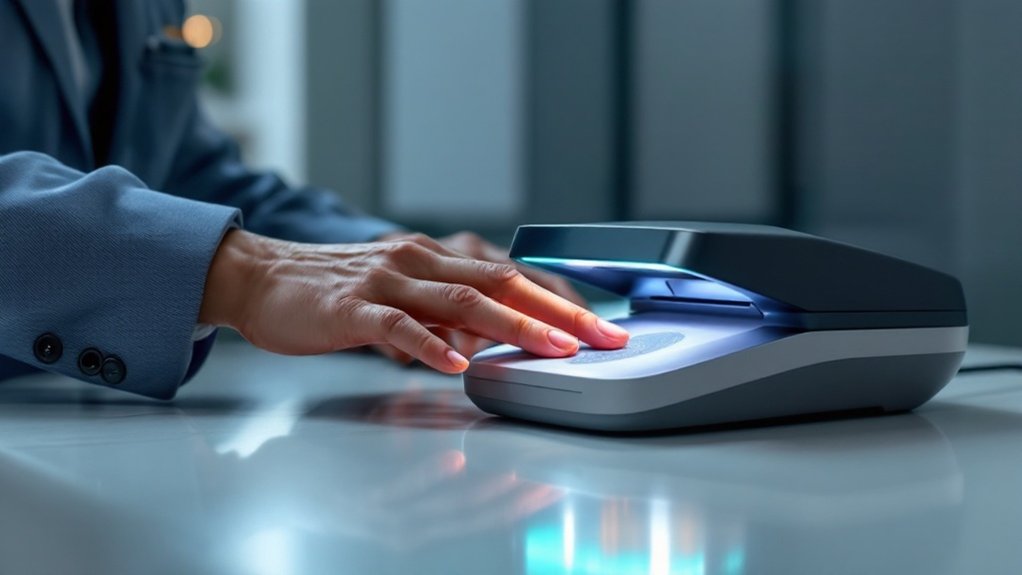
Ensuring legal and regulatory compliance is fundamental when implementing Live Scan fingerprinting. You must notify employees of the fingerprinting requirement and obtain written consent, adhering to state-specific laws and regulations. Using certified and state-approved vendors is essential, as they must be FBI-certified to meet federal standards. Proper identification and form completion are also required, ensuring privacy protections are in place. Additionally, maintaining compliance involves understanding that Live Scan is often mandatory for certain positions, such as notary public applicants in California, to ensure thorough background checks. To maintain compliance, you should conduct regular audits of equipment and processes. Staying updated with industry standards and regulations through training and legal consultation is indispensable. Implementing robust data security measures protects biometric data and prevents legal liability. Compliance helps maintain a good reputation and avoids legal consequences.
Optimizing Operational Efficiency**
As you implement Live Scan fingerprinting, you’ll considerably enhance operational efficiency by reducing processing time and minimizing errors. By digitizing records and streamlining processes, you can efficiently manage data and submit it electronically to relevant agencies, saving time and resources. This approach also allows you to optimize software and equipment, ensuring that your operations are cost-effective and highly efficient. Additionally, starting a Live Scan business requires an initial investment in live scan equipment, which can be covered through accessible financing options without needing angel investors.
Optimizing Operational Efficiency
Optimizing operational efficiency is critical for businesses and organizations that rely on Live Scan fingerprinting for background checks and identity verification. By using Live Scan, you can streamline processes, reduce costs, and enhance compliance. This technology also supports compliance with local, state, and federal regulations by ensuring secure and accurate data transmission.
- Accuracy and Reliability: High-resolution images reduce errors and guarantee accurate submissions.
- Digital Transmission: Electronic transmission eliminates the risk of losing or damaging physical cards.
- Faster Turnaround Times: Results are typically available within 72 hours, facilitating quicker hiring processes.
- Cost Savings: Long-term savings are achieved by eliminating ink, paper, and mailing costs. This approach helps you operate more efficiently and effectively.
Streamline Processes
To streamline processes in Live Scan fingerprinting, you can greatly enhance operational efficiency by leveraging digital technology. You’ll receive forms from the requesting agency, including the ORI number, and can schedule appointments online, by phone, or in person. Confirming payment methods and amounts with providers is essential, and a valid photo ID is required for identity verification. By utilizing Live Scan technology, the process eliminates the need for physical fingerprint cards, allowing for faster and more accurate fingerprint acquisition.
Efficient Software
How can you maximize the efficiency of your Live Scan operations? By leveraging efficient software, you can streamline your processes substantially. Live Scan software includes features like real-time quality checks, guaranteeing high-quality fingerprint captures and minimizing errors. It also supports electronic submission to agencies, enhancing speed and security. Efficient Live Scan systems are particularly beneficial because they significantly reduce the likelihood of errors such as smudges or incomplete prints, which were common with traditional ink-based methods.
Some key features of efficient Live Scan software include:
- Real-time Quality Checks: Guarantees high-quality fingerprint images.
- Compatibility with Hardware: Works with various FBI-approved scanners.
- Customization Options: Tailored to meet specific business needs.
- Security Measures: Includes features like liveness detection to prevent spoofing.
Conclusion
You’ve navigated the Live Scan fingerprinting process like a sailor charting a course through uncharted waters. By following these steps, you’ve guaranteed a smooth journey from preparation to compliance. Now, your fingerprints are electronically submitted, and you’re ready to move forward with your application. This streamlined process not only saves time but also ensures accuracy, making it an essential tool in today’s digital landscape.

